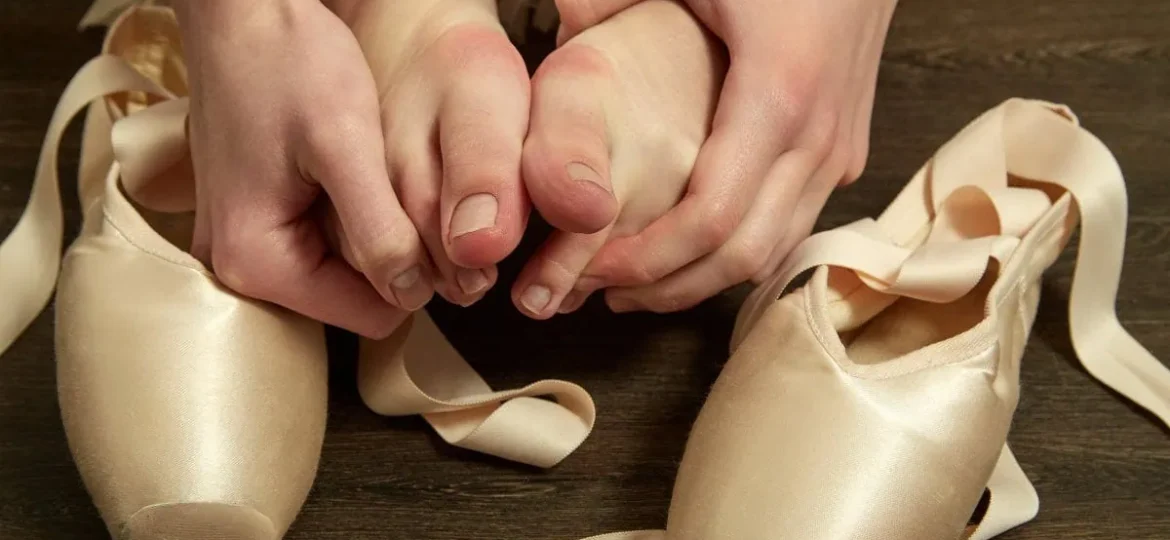
Ballet dancing is a beautiful art form that requires extraordinary skill, dedication, and physical conditioning. However, the demands placed on ballerinas’ feet and ankles can lead to various types of foot damage. This blog explores common injuries and issues, providing insights into causes, symptoms, prevention, and treatment for ballerina feet damage.
Causes of Why Ballerinas Could Suffer From Damaged Feet
Ballet dancing involves rigorous training and specific techniques that can put significant stress on the feet and ankles. Key causes of foot damage in ballerinas include:
- Pointe Work: Dancing on the tips of the toes in pointe shoes creates immense pressure on the feet, especially the big toe. This can lead to injuries such as stress fractures and plantar fasciitis. The unnatural angle and the constant force on the toes contribute to the risk of developing these conditions.
- Body Weight: The repetitive force exerted by a ballerina’s body weight on the feet can contribute to foot injuries and long-term damage. Each leap, turn, and landing applies stress on the feet, making them susceptible to chronic conditions if not properly managed.
- Pointe Shoes: Improperly fitted or worn-out pointe shoes can exacerbate foot problems, including blisters, calluses, and ingrown toenails. Shoes that do not provide adequate support can lead to an imbalance, putting additional strain on the feet.
- Pointe Technique: Incorrect pointe technique may increase the risk of stress fractures, sprained ankles, and Achilles tendonitis. Issues like over-arching the foot or incorrect placement on the pointe can lead to significant stress and subsequent injuries.
What are some Symptoms of Damaged Ballerina Feet?
Ballerinas may experience a variety of symptoms related to feet damage, including:
- Pain: Persistent or sharp pain in the big toe, arch, or heels could be a sign of conditions like plantar fasciitis or stress fractures. Pain that intensifies during or after dancing is particularly concerning.
- Swelling: Swelling around the ankles or feet may indicate a sprained ankle or other injuries. This can affect a ballerina’s ability to perform and should be monitored closely.
- Redness and Warmth: Inflammation often causes redness and warmth, particularly around affected areas. This can be an early indicator of more serious issues if it persists.
- Blisters and Calluses: Frequent friction and pressure can lead to painful blisters and calluses on the feet. While calluses might be less concerning, blisters can become infected and require special care.
What Can Ballerinas Avoid To Minimize Foot Injuries?
To minimize the risk of foot injuries, ballet dancers should avoid:
- Overuse: Excessive practice or performance without adequate rest can lead to chronic injuries and stress fractures. It’s crucial to balance training with rest to allow the body to recover.
- Improper Footwear: Using old or ill-fitting pointe shoes can exacerbate foot issues. Ensure proper fit and regular replacement. Investing in high-quality, well-fitted shoes can prevent many common foot problems.
- Ignoring Pain: Pain is a warning sign. Continuing to dance despite discomfort can lead to more severe damage if left untreated. Listening to the body and addressing issues early can prevent long-term complications.
Damaged Ballerina Feet – Treatment and Recovery Options
Addressing injuries promptly is crucial for recovery. Recommended ballerina feet damage treatments include:
- Rest and Ice: The affected area will find more relief when ice is applied, foot and To reduce pain and swelling, this is a fundamental first step in managing most injuries.
- Proper Footwear: Switching to well-fitted pointe shoes and using supportive orthotics can aid in recovery. Patients have also found success with custom-made orthotics because these provide additional cushioning and higher support.
- Physical Therapy: Exercises and stretches prescribed by a physical therapist can help rehabilitate injured feet and strengthen supporting muscles. This might include techniques to improve flexibility and strength in the feet and ankles.
- Medication: Over-the-counter pain relievers or prescribed medications can manage pain and inflammation. However, it’s important to use these under the guidance of a healthcare provider to avoid masking serious issues.
When Should You See a Podiatrist
It’s important to consult a podiatrist for persistent or severe symptoms for ballerina feet damage, including:
- Unresolved Pain: If pain does not improve with rest and basic care, it may indicate a more serious condition like a stress fracture or Achilles tendonitis. A podiatrist can provide a thorough examination and appropriate interventions.
- Swelling and Bruising: Significant swelling or bruising, especially if accompanied by difficulty moving the foot or ankle, warrants professional evaluation. These symptoms can indicate more serious underlying injuries.
- Blisters and Calluses: If blisters and calluses become infected or excessively painful, a podiatrist can provide appropriate treatment and prevention advice. Proper management of these issues is essential to prevent further complications.
Understanding and addressing the various types of foot damage that ballerinas experience is crucial for maintaining both their health and their performance on stage. By becoming aware of the specific causes and symptoms of foot injuries, ballet dancers can take proactive measures to protect their feet and mitigate the risk of long-term damage.
Early recognition and appropriate treatment of issues like stress fractures, plantar fasciitis, and Achilles tendonitis can significantly reduce discomfort and prevent more severe injuries from developing.
Ballet dancers should prioritize regular check-ups and adhere to a consistent foot care routine to maintain optimal foot health. This includes routine assessments to catch potential issues early, as well as integrating practices like proper footwear, stretching, and strengthening exercises into their daily regimen.
For those seeking expert guidance for ballerina feet damage, patients can visit Certified Foot and Ankle Specialists who are equipped to provide comprehensive care. With 14 convenient locations available, our doctors offer a range of services designed to address and treat ballet-related foot injuries. Their expertise ensures that dancers receive tailored treatment plans, from initial evaluation and diagnosis to personalized recovery strategies. By leveraging the resources and knowledge of these professionals, ballerinas can safeguard their feet, enhance their performance, and continue pursuing their passion with greater confidence and minimal pain.
For more details on foot health and related conditions, Visit our nearest podiatry clinic in Tampa and Brandon locations or schedule an appointment with our experienced podiatrist today.


